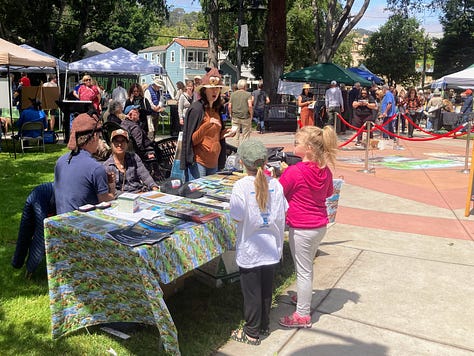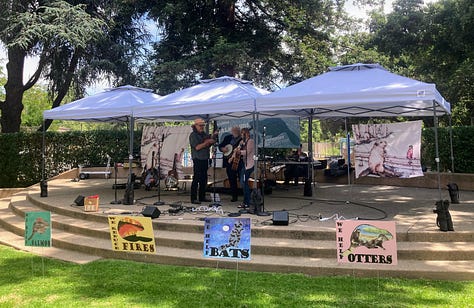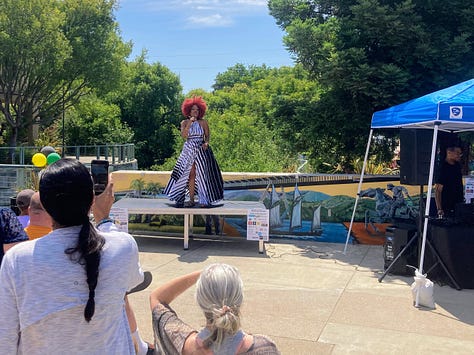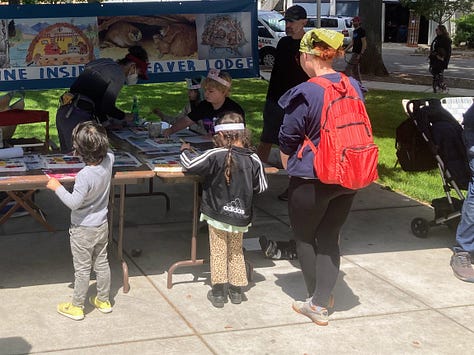2001 Accidents at Martinez Refinery Were Eerily Similar to Last Thanksgiving's "Spent Catalyst" Release. Here's What Happened Then, and How the Response Was Different
In two incidents in October 2001, the refinery's then-owner properly activated the Community Warning System, a stark contrast to what happened in 2022; MRC details corrective actions it is taking
Note: Scroll to the bottom of this post for a photo gallery from Saturday’s Juneteenth and Beaver Festival celebrations in downtown Martinez.
As investigations continue into the November “spent catalyst” release from the Martinez Refining Co. that showered the surrounding community in toxic dust, Contra Costa County hazardous materials records indicate this wasn’t the first time that such an incident occurred at the refinery’s Catalytic Cracking Unit (CCU).
But it apparently was the first time that this or any other Contra Costa Costa County refinery failed to activate the Community Warning System as required by law in a major accident.
In the span of three days in October 2001, the same unit responsible for the release last Thanksgiving night experienced two “upsets” during start-up procedures that sent hazardous materials, including soot and catalyst, into the community. The incidents are listed on the website of the Contra Costa Health Services Hazardous Materials Division along with scores of other refinery and chemical accidents in the county dating to the early 1990s.
While what happened at MRC last November wasn’t unique to a community and county long accustomed to the hazards of petroleum refining, the failure to notify health authorities and the public through the CWS, which dates to the early 1990s, clearly was.
In response to my inquiry about the 2001 incidents with Contra Costa Health Services (CCH) last week, the agency said that on both Oct. 14 and Oct. 17 of that year, the refinery’s then-owner, Equilon (Shell), “properly activated” the Community Warning System. In fact, in reviewing its records for past refinery accidents, Contra Costa Health’s public information office said that “we did not find any other examples (outside of the November 24-25, 2022 MRC spent-catalyst release) where a facility failed to notify CCH for a Community Warning System (CWS) Level 2 or 3 incident.”
The agency did say there have been cases over the years where it has “experienced untimely (late) notifications from facilities for hazardous materials releases.”
Contra Costa County Supervisor John Gioia, in an email Wednesday, echoed that point, saying, “I will say, in my 25 years on the Board of Supes, this is the only time I’ve recalled a total failure (by a refinery) to activate CWS in a major release. There have been a number of cases where the refinery activated it or notified the county later than they should have.”
Had the Community Warning System been activated last November as required, the spent catalyst release would have qualified as a Level 2 alert, according to Contra Costa Health, indicating potential off-site risks for sensitive groups. In addition to immediately responding to the accident with hazmat crews, Contra Costa Health would have issued notifications through its regular internet and social media platforms as well as notified local media outlets of the release.
MRC, now owned by PBF Energy, has said in public statements and in its own root cause investigation that it didn’t activate the CWS because it was unaware of the major release of 20 to 24 tons of spent catalyst until it was informed by residents the next day who called to inquire about the dust found on their property. Contra Costa Health did not learn about the incident until two days after it began when complaints circulated through the the community and social media.
I asked MRC for comment about why refinery personnel would have been able to detect the releases involving catalyst from the Catalytic Cracking Unit in 2001 and immediately activate the Community Warning System, but not in 2022. Spokesperson Brandon Matson responded that “we are unable to comment on an incident that occurred 19 years before we acquired the refinery.”
According to MRC, the Thanksgiving night incident was prompted by a pressure imbalance that occurred during the “re-introduction of feed” to the Catalytic Cracking Unit after it had been placed in “hot standby” three days earlier because of a process problem. Workers were unable to control a resulting rise in the catalyst bed level (catalyst is a solid, sand-like substance used in refineries to improve the refining process and yield more, higher-quality fuel). This resulted in what MRC called an “opacity event” — a technical term that Matson described as “effectively a measurement of how much light is being blocked by particles coming out of the carbon monoxide boiler stacks.”
This is the explanation MRC gave in its own root cause analysis for the failure to activate the Community Warning System.
During the incident, because there was nothing seen on refinery units and equipment or inside the refinery property and there were no calls from the community, MRC personnel were unaware that the opacity event resulted in any release into the community.
After receiving community calls reporting visible particles the morning after Thanksgiving, MRC personnel began investigating whether the material originated from a reported nearby fire or was related to the refinery. MRC communicated with regulatory agencies on Friday night and Saturday.
There was (and currently is) no mechanism to alert MRC personnel to the potential that an opacity event might result in a release of catalyst into the community.
Tony Semenza, who was instrumental in the creation of the Community Warning System as head of the nonprofit group Community Awareness and Emergency Response (CAER) and is a member of the county-led MRC Oversight Committee investigating the Thanksgiving incident, said refinery personnel “should have known about the possibility that something was going out into the community.”
“It should have been quickly reported,” said Semenza, a former fire chief at Chevron’s Richmond refinery who has been intimately involved for decades in safety issues regarding refineries and other industrial plants. “The county could have used whatever tools they thought appropriate to get information out to the community. MRC made a mistake, and they are paying for that mistake with a reputation that was very good in the community. The issue now is to build back that trust with the community.”
Matson said in his Friday email that should another “opacity event” occur at the refinery, MRC will automatically activate the Community Warning System regardless of whether it has verified a hazardous release. He wrote:
Within weeks of the 2022 incident, we updated our response procedures to require that we issue a Community Warning System (CWS) notification and conduct immediate community monitoring during opacity events, even when the potential for a release into the community is unlikely.
When the same Catalytic Cracking Unit released catalyst and other hazardous materials into the community on Oct. 14 and Oct. 17, 2001, the refinery apparently had no trouble detecting the release and notifying the community through the CWS (it should be noted that those incidents released much less catalyst into the community than the Thanksgiving 2022 accident but also released significant quantities of hydrocarbons and soot, which were not reported from the 2022 release).
According to summaries provided by Contra Costa Health, here is what happened during the incidents on Oct. 14 and Oct. 17, 2001.
Oct. 14: During startup of the CCU, refinery staff had a problem that resulted in a release that was initially described as soot, catalyst and hydrocarbons that dusted the community north of the refinery. Odors were reported over a mile from the refinery. A Level 3 CWS incident was issued, and sirens were sounded. Initial estimates identified that over 5,000 pounds of hydrocarbons were released. After the refinery’s investigation was performed, the facility identified that 9,160 pounds of hydrocarbons and approximately 1,500 pounds of catalyst were released. Particulate matter was deposited in neighborhoods primarily to the south of the refinery in an area generally bounded by Pine Street, Pacheco Boulevard, Morello Avenue and Arnold Drive.
Oct. 17: Three days after the first incident, the refinery was starting up its CCU again and had a more significant incident. This incident was initially identified to have released more hydrocarbons than soot and catalyst. A Level 3 CWS event was issued, sirens were sounded, and automated phone calls were made. Initial estimates identified that over 50,000 pounds of hydrocarbons were released. After the refinery’s investigation was performed, the facility identified that approximately 53,685 pounds of hydrocarbons and 75 pounds of catalyst were released. An oil film layer and soot landed in the nearby community on homes and vehicles. Following this incident, the CCU was shut down for two months while the accidents were investigated.
I lived in the same neighborhood I do now south of the refinery in 2001, and recall that several homes were covered in soot or dust by one or both of the incidents. The refinery at that time not only offered free car washes to affected residents but also power washed homes.
Given the release of hydrocarbons and soot in addition to catalyst from the 2001 incidents at the Catalytic Cracking Unit, I asked Contra Costa Health whether it’s possible any hazardous materials other than the spent catalyst were released during last November’s accident. The agency provided the following statement:
To date, CCH not been told by MRC that anything else other than spent catalyst was released November 24-25, 2022. Certainly, the independent investigation that the county is conducting will evaluate the entire incident, including what was released from the refinery.
Because the CWS was not activated, CCH did not respond during the actual release. Therefore, we are relying on information provided by MRC and our upcoming incident investigation to let us know what was released during the incident.
I also posed the same question to Matson, who responded that “spent catalyst is the only material that was released during the incident.”
CCH also said the MRC Oversight Committee “will be able to provide a summary comparing the causes of the 2001 incidents to the 2022 incident” once its investigation is completed. The Thanksgiving release, and failure to notify the public, is also under investigation by the Contra Costa District Attorney’s Office, FBI and U.S. Environmental Protection Agency.
Meanwhile, Matson of MRC says the refinery has taken a number of corrective equipment, procedural and training actions in response to the incident:
Automating control changes that had previously been manually operated to enhance their effectiveness
Updating procedures and alarms to provide additional instructions for MRC personnel to respond effectively to the type of process conditions that led to the incident
Additional operator training on steps to take to correct the process conditions that led to the release
Of 11 specific corrective actions in these areas, Matson said three have been completed and the remainder are scheduled to be addressed by the end of July.
In addition to the 2001 incidents, the list of major refinery accidents from 1992 to 2018 on the county’s hazardous materials website lists the following at the MRC refinery (all under Shell’s ownership):
Small fire and flaring on July 6, 2018
Excessive flaring resulting from loss of power on Dec. 19, 2016
A Level 2 Community Warning System alert resulting from flaring with black smoke on Aug. 14, 2012 (this incident resulted in a number of odor complaints from the community.)
A small fire that sent a visible black cloud into the air on Aug. 13, 2012
A release of sulfur dioxide gas that resulted in a Level 3 CWS alert on March 26, 2006.
What was described as “oil catalyst/slurry mix” coated vehicles and pavement southwest of the refinery resulting from a leak that also injured a contractor with first, second and third degree burns on Nov. 8, 2005.
A small fire that triggered a Level 3 CWS alert on Jan. 11, 2003
A black plume of smoke originating from the refinery’s Sulfur Recovery Unit that triggered a Level 3 CWS alert on April 13, 2002
A Level 3 CWS alert resulting from the release of smoke and hydrocarbons on July 18, 2001
A fire at the refinery’s cracked gas unit in May 1996 that lasted for over three hours and caused extensive damage to the refinery.
Semenza told me that the frequency of major refinery accidents in the county has declined significantly in recent decades thanks in large part to the county’s Industrial Safety Ordinance and annual safety summits (69 to date) sponsored by CAER among local refineries to discuss, among other things, lessons learned and near misses. He estimated that from 1982 to 2002, there were “probably 27, 28” refinery accidents that would have qualified as Level 3 or greater alerts under the CWS. “The number of Level 3 incidents has gone down because of the tremendous amount of sharing on safety,” he said.
The impetus for implementation of the Community Warning System, he said, came from a major accident at the General Chemical plant in Richmond on July 26, 1993, that caused 22,000 people to seek medical attention after a cloud of sulfuric acid drifted over the community.
Contra Costa Health recently completed a special safety audit of MRC’s Catalytic Cracking Unit in response to the Thanksgiving night accident. According to the agency, hazardous materials staff are currently preparing and internally reviewing the report, and expect that it will be publicly released by the end of July.
Much of the focus of the MRC Oversight Committee and Martinez community in recent months had been on the analysis of soil samples to determine any long-term health or environmental risks from the catalyst dust; that has been completed with a finding that, based on toxicology tests, the release “did not increase risk to public health from exposure to hazardous metals in the soil.” But there is clearly much still to learn about this accident, in terms of its causes, impacts and, perhaps most important, why for apparently the only time since its introduction more than a quarter century ago, the county’s Community Warning System was not activated for a major refinery release.
The next oversight committee meeting will be Thursday at 10 a.m. on Zoom. The link to join: https://zoom.us/j/93347655065
Juneteenth and Beaver Festival celebrations
Martinez held its first Juneteenth celebration at Main Street Plaza on Saturday afternoon. Now a federal holiday, Juneteenth has long been celebrated in the Black community as the date that marked the final emancipation of slaves after the Civil War. At the same time, the Martinez Beaver Festival, which has become an annual tradition following the story of the famous Martinez beavers and their downtown dams 15 years ago, was held a few blocks away at Susana Park. Here is a gallery of photos I snapped of the festivities from both events, which featured music, informational tables, speeches, kids’ activities, food and more.













There was a typo in the year in this sentence that has now been corrected: According to summaries provided by Contra Costa Health, here is what happened during the incidents on Oct. 14 and Oct. 17, 2001.
It appears there was a glitch in the photo gallery via email. For those who want to take a closer look at the photos, click the link to open online at the top of the email or click this link: https://open.substack.com/pub/martineznewsandviews/p/2001-accidents-at-martinez-refinery?r=tm6pf&utm_campaign=post&utm_medium=web